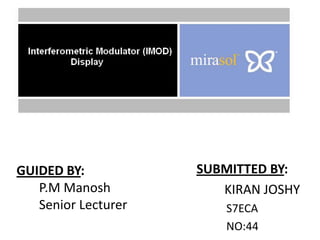
Seminar on imod
- 1. SUBMITTED BY: KIRAN JOSHY S7ECA NO:44 GUIDED BY: P.M Manosh Senior Lecturer
- 2. OVERVIEW OVERVIEW OF PORTABLE DISPLAYS STRUCTURE WHAT IS IMOD? HOW IT WORKS COLOR GENERATION MEMORY HYSTERISIS LOOP IMOD ADDRESSING ADVANTAGES APPLICATIONS
- 3. OVERVIEW OF PORTABLE DISPLAYS Emissive/Transmissive Displays Reflective Displays (Continuous refresh type) Reflective Displays (Bistable type) Transflective Displays
- 4. Emissive/Transmissive Displays: Have two transmissive substrates. Liquid crystal material resides in between them. Backlight is placed underneath one of the substrates . Disadvantages-Large power consumption Continuous refreshing Example: LCD, OLED
- 5. Reflective Displays (Continuous refresh type): One reflective and the other transmissive. LC material resides over the top of reflective substrate. Since there is no backlight in reflective displays, they consume substantially less power than emissive displays. The majority of these types of displays must constantly be refreshed or the displayed image will be lost.
- 6. Reflective Displays (Bistable type): A bistable display is capable of maintaining one of two states (on or off) without any external influencesuch as an electric field. Image can be maintained for a long time. Example: EPD and mirasol displays. No refreshing required. No Back light. Hence consume little power.
- 7. Transflective Displays Transflective displays utilizes the property of both transmissive and reflective displays. In low light situations, the device operates as a transmissive display, employing the backlight. In high ambient light conditions, the backlight turns off and the display functions as a reflective display.
- 8. WHAT IS AN IMOD ? Interferometric Modulation(IMOD) is a new display technology that produces fantastic colors by exploiting the physical effect of interference of light while using little of the limited battery power. Main advantages-Paper like readability Low power consumption.
- 11. Optical cavity .
- 12. Interference.
- 13. Have two states : Open state Collapsed state Figure 2
- 14. Figure 4
- 17. Color Generation: Figure 5
- 20. The electrostatic force can be defined as:
- 21. At equilibrium the net force must be zero. Therefore
- 22. Linear Restoring Force Vs Non linear attractive force Figure 7
- 23. HYSTERISIS LOOP Figure 8
- 25. Short activation pulse to switch to collapsed state.
- 26. Short release pulse to switch to open state.Figure 9
- 28. Figure 10
- 29. Figure 11
- 30. ADVANTAGES: Speed Readability Robustness Low power consumption Industry Compatibility True-to-life Image quality Ease of Manufacture
- 34. Mirasol displays utilizing the air gap are capable of performing over an extended temperature range (-30 to 70 deg).
- 36. Due to the bistable nature.
- 37. No need of refreshment.
- 39. APPLICATIONS: Gaming devices MP3 players Laptop and desktop monitors Digital TV and DVD player screens Medical imaging Digital camera and camcorder screens
- 41. Inventec V112 Smartphone 1.1" Bichrome
- 42. Cal-Comp iT-810 Handset 1.2" Bichrome
- 43. Hisense C108 Handset 1.2" Bichrome
- 45. Inventec V112 Smartphone G-CORE_Mini-Caddy KTF_ShowCare Hisense C108 FreestyleAudioFA300_B Figure 14
- 46. CONCLUSION IMODs are powerful photonic devices that can be used as excellent displays for manipulation of light not only in cell phones but also in camcorders, computer monitors, wall mounted TVs, etc. All in all, in the coming days, IMOD displays are likely to replace other devices.
- 47. REFERENCES Electronics for you(Nov-2008) M.W. Miles, “Toward an iMoD ecosystem” www.wikipedia.org/wiki/Interferometric_modulator_display www.qualcomm.com/common/documents/white_papers/QMT_Technology_Overview_.pdf www.qualcomm.com/common/documents/white_papers/QMT_Operating_Principles_IMOD_Drive.pdf
- 48. THANK YOU